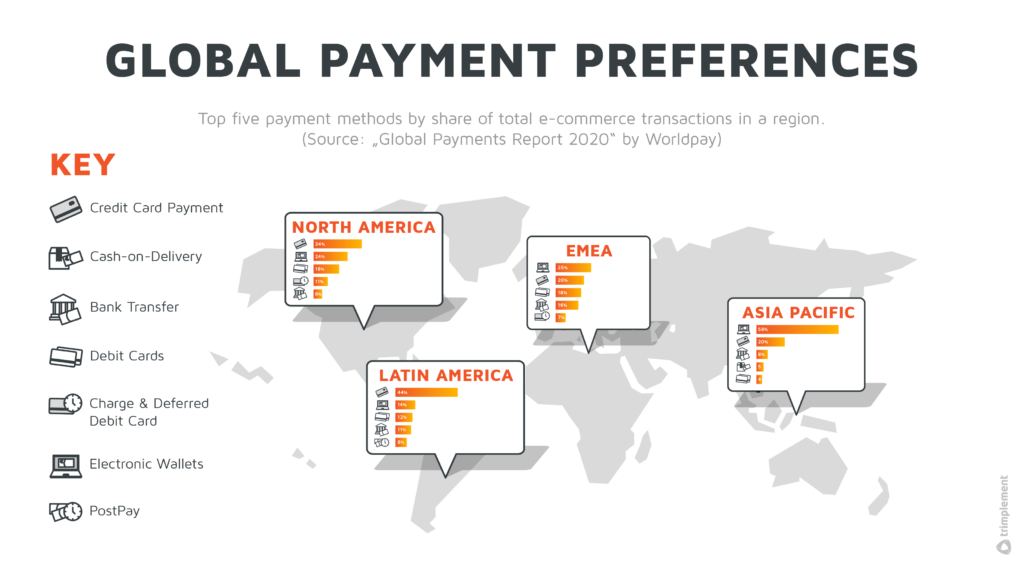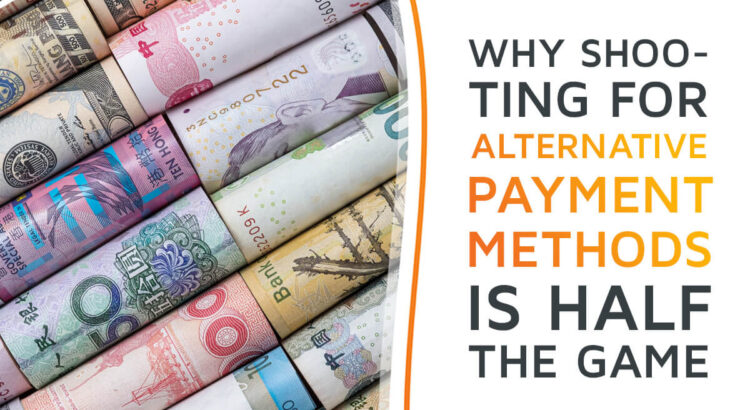Around 200 different payment methods exist around the globe – every single one has its fans. That’s not surprising: Our local payment culture influences which payment methods (or payment service providers) we prefer. Factors such as perceived payment trends, word-to-mouth, and genuine economic and regulatory conditions all shape our preference for one way of payment or the other.
For every company aiming for a new market, it’s crucial to understand the local payment customs inside out. And that’s just the preliminary: Integrating local payment methods and providers can be complex and costly on the technical side. This article will help companies without a payment software background navigate the playing field. How to set up a custom payment system that simplifies payment method integration?
The article details:
- The benefits and challenges of local payment methods
- Why a custom payment system makes alternative payment method integration easier
- How to set up a global payment system with CoreWallet, featuring an orchestration layer for local payment methods
Let’s begin…
Hold On: What Counts As an Alternative Payment Method?
As a term, alternative payment method (APM) fits various definitions. They are often called local payment methods (LPM) as well.
In a narrower sense, local payment methods would refer to payment methods used only in one specific geographic area. Such payment methods have become rare in globalized, cross-border e-commerce. International payment providers operate in various countries and help alternative payment methods to go beyond the boundaries of restricted territories.
So, for this article, we define a local or alternative payment method as any payment method with a large following in a particular geographic part of the world. This “part of the world” may consist of one country or many.
It presents an alternative to the big Global Payment Schemes. Those dictate standards for a specific payment method on a close-to-worldwide scale. Take the credit card schemes Visa and Mastercard as examples here.
Types of Alternative Payment Methods
LPMs / APMs can take many shapes, each with their own infrastructure and user base. Common alternative payment methods used around the globe include:
Bank Transfers
An exchange between banks. The customer is typically shown a unique reference text and details of the bank account where they can make their payment. They transfer the money from their bank account to the bank account of the recipient. Regional standards such as ACH for the US, SEPA for the EUR zone and SWIFT for international bank transfers apply here.
Instant Bank Transfer
A variant form of bank transfer. Such transactions happen instantly in contrast to regular bank transfers, taking 2-3 days. Examples here are SEPA Instant Credit Transfer, and (with some deviations in the process) iDEAL and Sofortüberweisung.
Purchase-on-Account
The merchant sends out the goods right away but also sends an invoice (often on digital channels). Customers have to pay it by a specific deadline. Less prevalent in unbanked regions.
Direct Debit
The customer gives their consent that the merchant’s bank may withdraw the amount of the purchase from the customer’s bank account.
Electronic Wallets
Also called Digital Wallets or E-Wallets. Customers store digital fiat, virtual or crypto money in specific wallet software. They use this balance to pay with it. More about electronic wallets in this article!
Buy Now, Pay Later
BNPL in short. This payment method enables customers to receive an order right away. The system bails in for the customer and charges them later. The merchant receives their money right away. For more on Buy Now, Pay Later solutions, check out this article!
Cash-on-Delivery
Also known as CoD or collect-on-delivery. It allows consumers to pay for their goods in cash to the deliverer when they receive their order. Delivery firms often charge extra fees for CoD.
Prepaid Cards / Gift cards
Cards, which can be purchased in shops and store a fixed value in virtual or fiat currencies. The customer pays by spending the amount in designated online shops. Think Nintendo eShop or Amazon top-up cards here.
Vouchers
Upon checkout, customers get a voucher (a paying-in slip) with a unique, expiring payment reference. They take the voucher to a retail/convenience store or a specific ATM. It is validated there and the customer pays the order in cash.
Cryptocurrency Payments
Cryptocurrency payments don’t rely on banks to verify transactions. Instead, they use blockchain, a distributed ledger technology, to record all money transfers between participants. Only recently, online shops have begun to accept cryptocurrencies.
Direct Carrier Billing
Charging a payment to the bill of a mobile phone. Mostly obsolete today.
The Playing Field: Local Payment Methods Around the World
How popular the payment methods we mentioned above vary from payment culture to payment culture – from region to region. It’s dependent on factors like
- Financial regulations
- Digital infrastructure
- Stability of the local currency
- Online affinity of customers
- Rate of unbanked and underbanked population
- Competitive situation of local banks, e-commerce companies, and fintechs
- …
So, two adjacent countries may have completely different payment cultures. Or two countries located on two opposite continents may favor the same payment methods.
That said, we can identify trends for specific economic areas. North America, for instance, hosts the lowest number of unbanked people in the world. Debit Card and Credit Card payments are popular there.
In contrast, almost 3/4 of the populace of Latin America has no access to consistent banking services. Thus voucher payments account for up to 10% of all purchases and are especially popular for e-commerce orders. In China, digital wallets handle the comfortable majority of e-commerce payments. And in all of those regions Buy Now, Pay Later providers and electronic means of payment experience an increase in popularity.

But Will It Pay Off – Benefits of Alternative Payment Methods
So, that’s the game: Offering a vast array of alternative payment methods, each with its own playing field unique to a specific region.
But the question is: Should you even compete?
Will it pay off to provide every popular payment method in a region?
The short answer is: It will. We can list many reasons, why your company should support local payment methods, such as
- Alternative payment methods are widespread, making up 77% of annual consumer transactions.
- Alternative payment methods grant access to specific customer bases (e.g. unbanked customers, and digital-savvy customers).
- Alternative payment methods show customers that the platform belongs to their culture, boosting conversions and trust.
…
Integrating Local Payments – The Challenges
Offering alternative payment methods comes with benefits. But it also poses challenges to companies – some of which might prevent them from considering LPMs at all. The most prominent would be:
Costs
Every alternative payment method you integrate will come with development and maintenance costs – initial and ongoing. Besides, you might be charged usage fees by PSPs.
Payment Market Knowledge
To establish your e-commerce platform on the local market, you have to identify the payment “fan blocks”: the preferences of the buyers there. In addition, to get a good grip on the local payment providers and their business terms, you might have to involve consulting agencies.
Regulatory Compliance
Every payment market has its own regulations – on top of the international standards that already apply. Your company must be compliant with local KYC and AML requirements and also ascertain legal security for all operations. This includes obtaining necessary licenses.
Refunding
Customers put much emphasis on a good shopping experience. This includes returns and refunds. Paying back money after returning a purchase can prove tricky with some payment methods, i.e. cash-on-delivery.
Risk Monitoring and Fraud Prevention
Failing to protect customers from fraud will damage your business. And when you handle multiple payment methods, this will increase the number of anti-fraud measures you have to take. Also, keep in mind that some ways of payment are more vulnerable to fraud than others. Certainly, you will want to limit access to certain payment methods to customers with higher risk scores.
Payment Orchestration Layers – Simplifying Local Payment Method Integration
If you want to offer a diverse range of payment methods you have two options as a company:
- Implementing payment service providers (PSPs) one by one, using each PSP’s unique payment system.
- Setting up a unified payment orchestration layer as part of a custom payment system.
The first approach has the advantage, that it can be more quickly – given you are only targeting a few distinct markets with a small selection of payment methods.
Yet, if you want to expand your platform globally, this method suffers from certain limitations:
- You don’t have full control over your payments features
- You end up with a mess of singular integration points making your payment landscape overcomplicated.
- You have a harder time maintaining such a system, which costs more.
- You have to rely on the PSPs in question to prevent payment failure and cannot easily implement a fallback logic
- You might have to use several distinct payment analytics tools provided by the PSPs instead of bundling everything in one place.
What’s more, as your business expands, the number of PSPs and alternative payment methods will add up. New countries mean more integration points, which means more of the above.
Building an Alternative Payment Method Integration Layer
To prevent the problems showcased above, consider building a custom payment orchestration system.
Its big advantage: Having a single, unified integration layer. In it, you can integrate all the different local or global PSPs in a similar way. The payment orchestration layer hides the complexity of adding a new payment service provider or payment method and offers one single payment API to its consumers. Also, your team can easily adjust and maintain this unified system, saving time and effort.
Also, you can set up automatic payment routing in a custom system. Define rules and parameters to guarantee effective payments, telling the system to
- Choose the PSP with the highest success rate or least transaction costs for the given payment method
- Choose the fastest PSP in the peak times
- Choose a specific PSP and a specific payment method for a specific type of transaction
- Limit choice of PSPs and payment methods for customers depending on their risk scoring
And that are just a few ways how you can set up your payment orchestration layer. The point is, that you have the choice over how the system will turn out in the end. You can make it play off your budget, your platform’s operations, and your customer base perfectly.
CoreWallet – The Foundation for Your Alternative Payment Method Integration
However, it’s the “custom” in “custom payment integration system” that might discourage you. And it’s true, building your own payment system from scratch requires
- Development Time and Budget
- Experienced software engineers
- Domain knowledge and payment market expertise.
The thing is: You don’t have to build your payment system from scratch.
CoreWallet is a software foundation for building payment systems and electronic wallets. It contains all the features you would want in standard e-commerce flows, from pay-in to pay-out. What’s more, the software comes with pre-established integrations for some popular PSPs (Adyen, Paypal, etc.). Yet it also is flexible enough to integrate any local payment service provider in a unified integration layer within a short time frame.
CoreWallet is already processing payments in more than 50 countries now. Our team of experienced software engineers introduce you to the framework and support you in constructing the optimal payment experience for your business.



